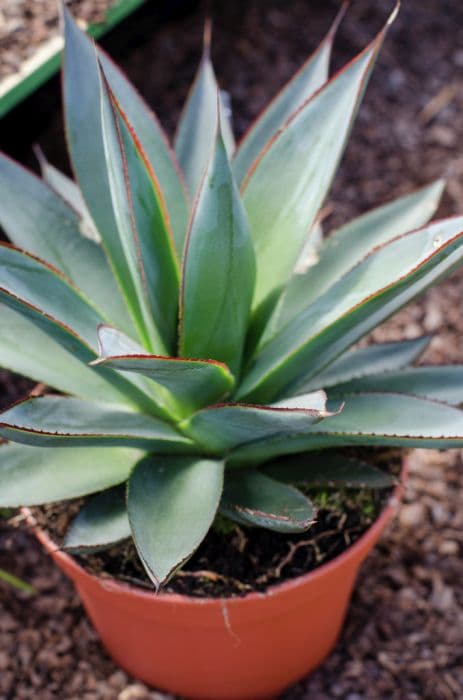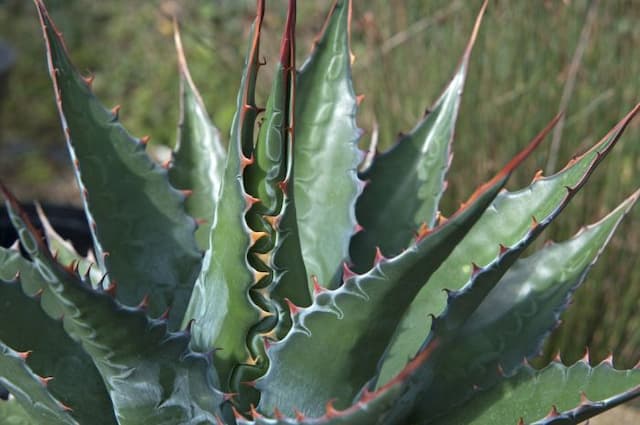Grape Hyacinth Muscari 'Jenny Robinson'

ABOUT
Muscari 'Jenny Robinson', commonly known as "grape hyacinth," is a charming perennial plant recognizable for its dense clusters of small, urn-shaped flowers. The blooms are typically a soft shade of blue, often described as pastel or sky blue, and they form tight conical spires that resemble tiny grapes, which is where the common name derives from. These flower clusters sit atop sturdy, upright stems, which are surrounded by strap-like foliage. The leaves are a bright green color, narrow in shape, and provide a pleasant contrast to the delicate blue flowers that appear in the springtime. The overall aesthetic of the grape hyacinth is one of gentle color and a somewhat quaint, old-fashioned garden appeal. Its flower spikes have a subtle, sweet fragrance that adds another layer of enjoyment to this plant's presence in a garden setting.
About this plant
 Names
NamesFamily
Asparagaceae.
Synonyms
Grape Hyacinth, Bluebell.
Common names
Muscari 'Jenny Robinson'.
 Toxicity
ToxicityTo humans
Grape hyacinth, which is the most common common name for Muscari 'Jenny Robinson', is generally considered to have a low level of toxicity for humans. However, if ingested, it may cause digestive discomfort such as nausea, vomiting, and diarrhea. These symptoms are typically mild and self-limiting. As with any plant ingestion, it is wise to seek medical advice if significant quantities have been eaten or if symptoms are severe.
To pets
Grape hyacinth is also considered to have a low level of toxicity for pets. If pets, such as dogs or cats, ingest this plant, they may experience symptoms similar to those in humans, which can include vomiting, diarrhea, and general gastrointestinal upset. While the plant is not highly toxic, pet owners should still prevent their animals from eating ornamental plants, and contact a veterinarian if a pet has consumed a large amount of the plant or is showing concerning symptoms.
 Characteristics
CharacteristicsLife cycle
Perennials
Foliage type
Deciduous
Color of leaves
Green
Flower color
Blue
Height
6-8 inches (15-20 cm)
Spread
2-4 inches (5-10 cm)
Plant type
Bulb
Hardiness zones
4
Native area
Mediterranean
Benefits
 General Benefits
General Benefits- Low Maintenance: Requires minimal care once established, making it perfect for busy gardeners.
- Drought Tolerance: Can survive with less water, suitable for xeriscaping or areas with water restrictions.
- Attracts Pollinators: Draws in bees and butterflies, promoting biodiversity in the garden.
- Spring Blooms: Provides early spring color with its distinctive blue flowers.
- Easy to Grow: A hardy plant that thrives in a variety of soil types and weather conditions.
- Naturalizing: Spreads easily and can fill in areas, creating a carpet of color.
- Deer Resistant: Less likely to be eaten by deer, which can help protect other nearby plants.
 Medical Properties
Medical PropertiesThis plant is not used for medical purposes.
 Air-purifying Qualities
Air-purifying QualitiesThis plant is not specifically known for air purifying qualities.
 Other Uses
Other UsesAs a natural dye: The Grape Hyacinth can be used to create a light green dye for textiles, offering an eco-friendly dyeing option.
As a floral flavoring: The blossoms can be crystallized and used as a delicate garnish for desserts or as a unique floral flavor in gourmet dishes.
In perfumery: Though not common, Grape Hyacinth's fragrance could potentially be captured and used in creating custom perfumes.
As a garden pest deterrent: The Grape Hyacinth's strong scent is believed to repel certain garden pests, potentially serving as a companion plant.
In potpourri: Dried Grape Hyacinth flowers can add fragrance and color when mixed into potpourri blends.
As a theme in art: The unique shape and color of the Grape Hyacinth make it an interesting subject for botanical illustrations and garden-inspired artwork.
As a symbol in events: Its association with rebirth and happiness can make it a meaningful choice for celebrations such as weddings or spring festivals.
In educational gardens: Grape Hyacinth can be used to teach students about bulbous plants and their life cycles in a school garden setting.
As a photography subject: Its striking appearance provides an excellent opportunity for photographers to practice macro photography techniques.
In crafting: The dried flower heads can be used in making bookmarks, pressed flower cards, or in scrapbooking for a natural touch.
Interesting Facts
 Feng Shui
Feng ShuiThe Grape Hyacinth is not used in Feng Shui practice.
 Zodiac Sign Compitability
Zodiac Sign CompitabilityThe Grape Hyacinth is not used in astrology practice.
 Plant Symbolism
Plant Symbolism- Perseverance - Muscari, commonly known as Grape Hyacinth, often signifies perseverance due to its ability to bloom early in spring, sometimes pushing through snow.
- Trust - The dense clusters of Grape Hyacinth blooms represent trust in relationships, symbolizing the close bonds between people.
- Hope - As a harbinger of spring, Grape Hyacinth is a symbol of hope and new beginnings, as it's one of the first plants to flower after the winter.
- Constancy - The deep blue or purple color of Grape Hyacinth is traditionally associated with constancy and faithfulness in love.
- Rebirth - In line with its spring appearance, Grape Hyacinth embodies the theme of rebirth and the cycle of life, often used in celebrations that mark renewal.
 Water
WaterGrape Hyacinths, including the variety 'Jenny Robinson', prefer evenly moist soil, particularly during the spring growth and flowering period. It is recommended to water them deeply once a week, with about 1 inch of water each time, or enough to moisten the soil to a depth of at least 6 inches. After flowering and throughout the summer, reduce the watering frequency as the foliage begins to die back and the bulbs enter dormancy. In fall, increase watering slightly to support new root growth before the winter. Always adjust watering based on rainfall and avoid waterlogged conditions to prevent bulb rot.
 Light
LightGrape Hyacinths, such as 'Jenny Robinson', thrive best in full to partial sunlight. They should receive at least 4 to 6 hours of direct sunlight each day, making an east-facing or south-facing garden spot ideal for these bulbs. However, in hotter climates, some afternoon shade can be beneficial to prevent the flowers from fading too quickly due to excessive heat.
 Temperature
TemperatureGrape Hyacinths including the 'Jenny Robinson' variety, are hardy and can tolerate a wide range of temperatures. They can survive winter temperatures as low as 25 degrees Fahrenheit, but their ideal growing temperature during the active season ranges between 60 and 75 degrees Fahrenheit. They perform well in typical springtime conditions and go dormant once summer heat sets in.
 Pruning
PruningGrape Hyacinths such as 'Jenny Robinson' require minimal pruning. The main reason to prune is to remove spent flower stalks after blooming to promote tidy growth and potentially encourage reblooming. Prune the flower stalks at their base after the flowers fade, typically in late spring. Leave the foliage until it naturally dies back to allow the plant to store energy for the next season.
 Cleaning
CleaningAs needed
 Soil
SoilGrape hyacinths prefer well-draining soil with a pH of 6.0 to 7.0. A good soil mix for Muscari 'Jenny Robinson' would consist of equal parts garden soil, compost, and sharp sand or perlite to enhance drainage. Ensure the soil is fertile and does not retain excessive water to prevent bulb rot.
 Repotting
RepottingGrape hyacinths, like Muscari 'Jenny Robinson', typically don't need frequent repotting and can be repotted every 3-5 years. They thrive when slightly crowded, so only repot when the bulbs have multiplied and are visibly overcrowded in their current container.
 Humidity & Misting
Humidity & MistingGrape hyacinths such as Muscari 'Jenny Robinson' are tolerant of a wide range of humidity levels and do not require high humidity to thrive. They will grow successfully in average room humidity typically found in home environments.
 Suitable locations
Suitable locationsIndoor
Place in bright light, let soil dry between waterings.
Outdoor
Plant in well-draining soil; full sun to partial shade.
Hardiness zone
4-8 USDA
 Life cycle
Life cycleGrape hyacinth 'Jenny Robinson' begins its life cycle as a bulb, which remains dormant underground during the summer. In autumn, it starts to develop roots and foliage, taking advantage of cooler temperatures and moisture. Throughout the winter, the foliage remains green, and in early spring, the plant shoots up flowering stalks, adorned with small, bell-shaped, blue to purple flowers. After blooming, the flowers fade, and the plant directs its energy towards storing nutrients in the bulb for the next season. The foliage will eventually yellow and die back as the plant enters dormancy once more during the warm summer months. Each year, the cycle repeats, with bulbs potentially dividing and producing offsets, gradually forming larger clumps.
 Propogation
PropogationPropogation time
Spring
Propogation: The most popular method of propogating Grape Hyacinth 'Jenny Robinson' is through bulb division. This is typically done after the plant has finished flowering and the foliage has begun to die back, usually in late spring or early summer. To propagate, carefully dig up the bulbs and gently separate the smaller offset bulbs from the parent bulb. These offsets, also known as bulblets, should be replanted immediately at a depth of about 3 inches (approximately 7.6 centimeters) with a spacing of 3 to 4 inches (about 7.6 to 10 centimeters) apart. Ensure they are planted in well-draining soil with good sunlight, and water them in well after planting. Over time, these bulblets will grow into mature plants and produce their own flowers. This method of bulb division helps to increase the number of plants and maintain the vigor of the Grape Hyacinth garden.









